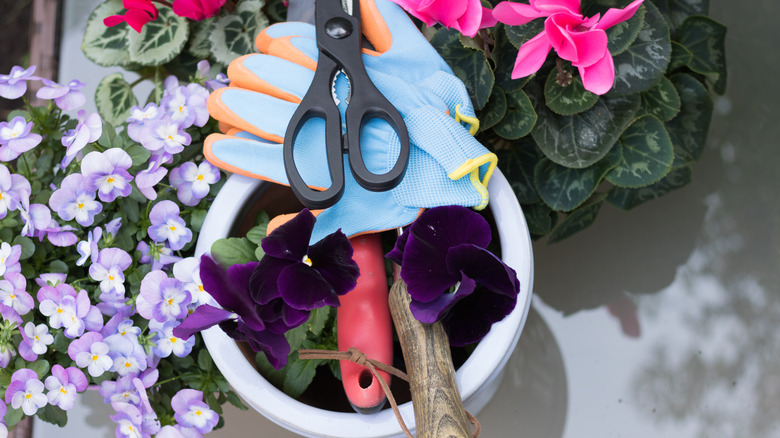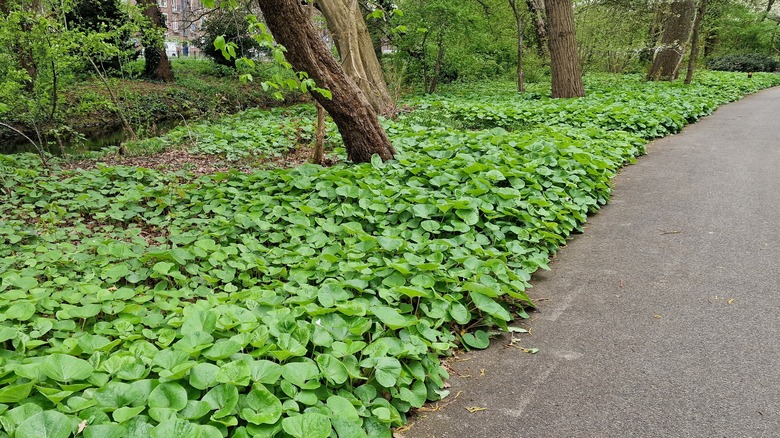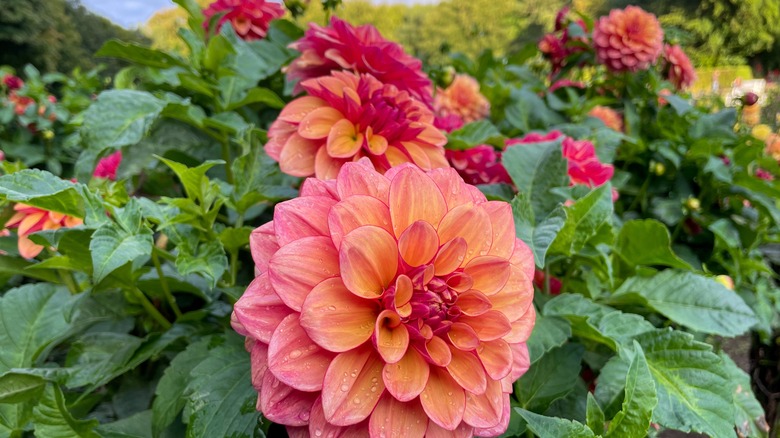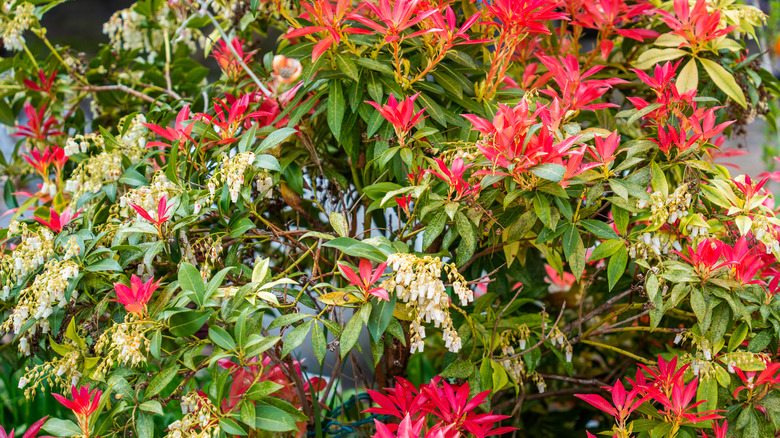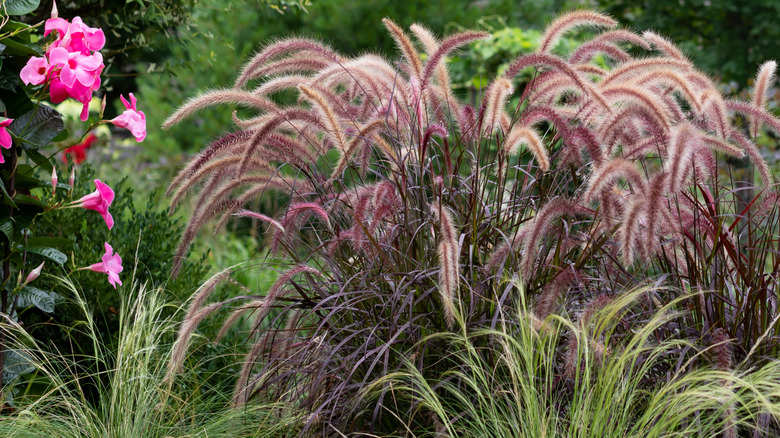Plants That Are Better Off Being Planted In The Spring Than In The Fall
Like those last colorful leaves on the prettiest of your deciduous trees, you might be hanging on to autumn and the last moments you can spend in your garden before winter's icy chill settles in among your flower beds and vegetable rows. Perhaps you're even hoping to do some fall planting in these last couple of weeks before the ground hardens. While there are plenty of flowers, perennials, shrubs, and bulbs that thrive when planted in November, don't make the mistake of thinking every plant will do so if you get it in the ground now.
Fall planting versus spring planting is about much more than mere air temperature. For anyone where the USDA plant hardiness zone clocks in at a 5 or 6 or below, you know that all it takes is one warm or sunny day to get the gardener in you hoping you can get out your trowel and dig in the dirt. But, check your growing zone and its hardiness before buying that bargain end-of-season perennial or package of bulbs, and remember that your patience will be rewarded with healthier, happier plants. In general, the plant categories that are better off planted in the spring rather than in the fall include most non-woody/herbaceous perennials, tender bulbs, evergreens, some ferns and grasses, some flowering trees, and most citrus trees.
Frost, soil, and non-woody or herbaceous perennials to plant in the spring
Once you've determined what the plant wants (read the instructions on the tag that came with the plant), and what your geographic locale can support, you're ready to pull on your gardening gloves. You'll want to have a good understanding of a plant's frost tolerance if you live in a frost-prone area. Frost is one of the top enemies of newly planted seedlings and young plants of all types. It's also important to know your soil and how your dirt matters when it comes to timing the dig. Soil that is heavy with clay will hold more water and could lead to the development of fungus in newly settled plants.
Some plants that are particularly sensitive to frost and soil conditions are non-woody, sometimes referred to as herbaceous, plants. They're the kind where the stems die back to the ground each year, like daylilies, lavender, Russian sage, and astilbe. They are also great plants for the landscape for a lot of reasons; wild ginger, for example, makes a great ground cover and thrives under a pine tree. But these perennials are at a higher risk for developing rot when they go into the ground in the fall, thus spring planting is a better option for them. When it comes time to plant, add some compost and place the crown of your perennial level with the ground or a bit higher.
Spring-planted bulbs provide months of blooms
Many bulbs are better off being planted in the spring rather than in the fall because they are considered tender and not well-suited to endure cold winter climates in the cooler hardiness zones. Spring-planted bulbs include dahlias, which put on a color bonanza and are prized as cut flowers, but they are sun worshippers that don't like to be cold. Other fan favorites among spring-planted bulbs include the graceful calla lilies, towering gladiolus (which can spike to as high as 4 feet), and everybody's favorite begonias. Many of the bulbs you plant in the spring will reward you with months of blooms beginning later in spring or summer.
Maybe every spring you look at some neighbor's yard, undulating with colorful flowers, and think to yourself, I should have planted lots and lots of fall bulbs for spring blooms. You may have missed the window for this season, but kicking off a new garden season by getting tender bulbs in the ground in spring. And, since dropping bulbs into the ground doesn't require digging a very deep hole, it isn't as daunting as planting a flowering bush or other larger perennial that needs a deeper hole — a prospect that isn't so pleasant if you live in a colder zone where the ground may have been under a blanket of snow for several months.
Plant these in spring if you want them to stay ever green
When it comes to planting the big things, like trees and bushes, gardeners are used to thinking of the autumn months as being the best time for getting out the shovels, but evergreens don't like that idea at all. Some evergreens attribute the dislike of adapting to their new digs to their many teeny tiny needles since it's through those needles that they lose water via evaporation. All that water loss during the cold winter months stresses the plants.
And it isn't just pines, firs, and spruces that feel needled by gardeners mistakenly planting them in the fall. Other evergreens like rhododendron, boxwood, Japanese Pieris – a unique gorgeous flowering shrub that thrives in the shade – and various arborvitae much prefer getting their roots tucked in once winter has passed. Evergreens need to be settled in their garden locations long enough to have their root structure dig into the surrounding soil long before the temperatures begin to plummet.
Just because it's the coast doesn't mean it's warm enough to plant
Even in California, where most people think it's always sunny and warm, gardeners should use caution before taking out their spades in cooler autumn months. Ticking in at 7, 8, or 9 on the USDA plant hardiness zone, the rainy areas, particularly the Northwest, tend to also be chilly throughout the winter and early spring months. This leads to the danger of frost or mold for plants, and newly-anchored ones are especially susceptible. Avoid planting popular varieties of plants, such as salvia and sages, various ferns, creeping rosemary, some geraniums, passionflower, and many hybrid varietals of fuchsia and calla lily.
Grasses and trees normally fare better than smaller plants, but not always. Most ornamental grasses don't mind going roots-deep in the fall, but Pennisetum setaceum 'Rubrum' (Purple Fountain Grass) isn't one of them — it's not a fan of rain or cool temperatures. If it's a tree you're considering planting, avoid planting flowering maple trees and citrus trees in autumn. While they might survive, neither is particularly well-suited for establishment during cool or wet months. They'll get a stronger, healthier start in the spring.
